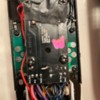You probably have a point there, they could be using the motherboard and a second microprocessor on that board (update, now betting it's the railsounds board) to perform the function.
The GG1 did have a special motherboard and we don't get to see the component backside.

Another thought, the Railsounds 5 board appear unique with an added diode on the back????

And the manual mentioning that for it to smoke in neutral, a 9V battery would be installed and that powers the railsounds board.
So does that imply the function is then off the railsounds board specific to the fan?
The smoke fan wiring harness clearly plugs into the motherboard on the 4 pin connector.

Again, 3 pin side goes to the smoke unit, center pin is frame ground, the other open spot in the socket is the smoke regulator wire making this blue wire the fan source.
Again, since we say this is timing based, so a microprocessor- and the Railsounds 5 did have a TRIAC onboard that can trigger and activate things. In this case, I think they used that to then fire the fan off, meanwhile the smoke resistor is heated and powered via the AC smoke regulator.



























